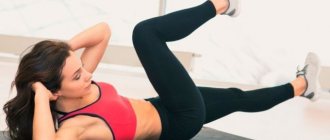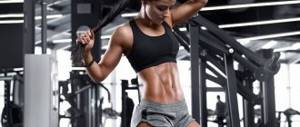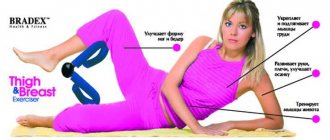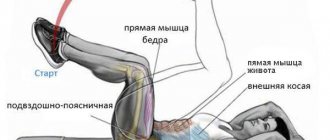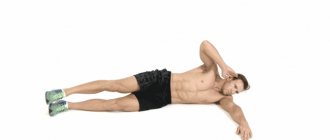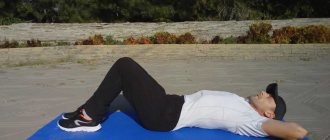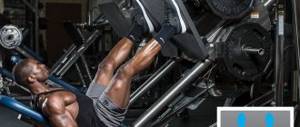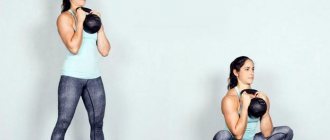General characteristics of the exercise
In sports, there are a large number of workouts that work the abs and work the oblique muscles. These exercises are performed both in the gym and at home. But it is recommended for experienced athletes to train in the gym using simulators, while beginners prefer to work with their own weight. One of the effective, but at the same time safe exercises for the abs are diagonal twists, which have a second name - lateral.
Ab crunches: technique of execution
The technique for doing abdominal crunches can vary depending on the type of exercise. First, let's look at the classic version. Proper technique is very important for him, as it increases the effectiveness of the exercise and prevents possible injuries. Classic straight abdominal crunches are the easiest, and beginners should master them first, and only then proceed to other variations of the exercise.
They are performed as follows:
- Lie down on the floor.
- Press your lower back to the surface.
- Your legs need to be bent at the knees so that there is a right angle between the thigh and shin. Place your feet on the floor.
- Your hands can be placed behind the back of your head, folded across your chest, or extended in front of you.
- Next, lift your torso, tensing your abdominal muscles. Only the shoulders should come off the floor surface, and the lower back should be pressed against it.
Throughout the entire approach, keep your abdominal muscles toned and do not relax them.
This way you can achieve maximum efficiency. Now repeat the exercise as many times as necessary. Also, when asking how to do abdominal crunches, consider the following points:
- When lifting, you should round your back rather than lift your entire torso.
- The feet should be firmly planted on the floor and not leave it.
- At the highest point, hold for a second and inhale as you lower. The muscles should remain tense.
The benefits of diagonal twists
By performing side crunches, you will receive a number of benefits:
- strengthening the rectus and oblique abdominal muscles;
- burning excess weight;
- the appearance of outlines and relief of the figure;
- toning muscle mass;
- improved blood circulation;
- removal of salt deposits;
- speed of result;
- ease of implementation;
- no need for special sports training.
Ab crunches: other options
When it comes to the question of how to do abdominal crunches, it is better to alternate different variations of the exercise in order to fully work out the muscles. Let's look at popular variations.
Reverse crunches
They differ from the classic ones in that you need to lift your legs, not your torso. They are done as follows:
- Lie down on the floor or on a bench.
- Bend your legs at the knees and raise them. Your shins should be parallel to the floor and your thighs should be perpendicular.
- You can put your hands behind your head or hold on to the edge of the bench.
- Tighten your abdominal muscles and pull your knees toward your chest. When your legs reach the extreme point, your pelvis should be elevated off the bench or floor.
- Stay in this position for a second.
- Lower your legs and repeat the twist as many times as necessary.
When exercising, it is important to ensure that your legs are lifted only by the efforts of your abdominal muscles. They cannot be extended, otherwise the load will be divided between the abs and hips.
Lateral or oblique crunches
Reverse crunches help work the oblique abdominal muscles. They are done as follows:
- Lie on the floor, bend your legs and turn them to the left.
- Place your right hand behind your head, place your left hand on your stomach, closer to the right side.
- Exhale, tensing the oblique muscles on the right side, try to reach the right elbow to the knee.
- Hold at the extreme point for a second, then return to the starting position.
This way you will work the right side. Then you need to perform the exercise in a similar way, but for the other side, so that the left oblique muscles are pumped up.
Diagonal crunches
Diagonal twists are similar to straight ones, but the technique suggests some differences:
- Lie on the floor, press your lower back to it, bend your knees to a right angle. You can also sit by the bed or bench, placing your feet on them.
- The right hand should be placed behind the head, and the left hand should be placed along the body on the floor.
- Now you need to lift your shoulder off the floor and try to touch your left knee with your right elbow.
- Once they touch, return to the starting position.
Then the same exercise is done on the second side. Remember that muscle tension should occur when you exhale, and you need to lower it when you inhale.
Double crunches
Double abdominal crunches are good because the load is distributed throughout the entire abs. This allows you to work out both the lower and upper abdomen well. They are performed as follows:
- You need to lie on your back, press your lower back to the surface of the floor, bend your knees to a right angle, place your feet on the floor.
- Place your hands behind your head without crossing your fingers.
- As you exhale, pull your chest and pelvis towards each other.
- Hold at the extreme point for a second, lower as you inhale, do not lower your shoulders to the floor.
When performing the exercise, do not pull your head with your hands. This will prevent injury to the cervical spine.
Incline crunches
Twisting the spine on an incline bench helps not only to pump up the abdominal muscles, but also to put stress on the rectus femoris muscles. This exercise is performed as follows:
- Adjust the tilt of the article so that the angle is 30-50 degrees. This will determine the load level.
- Sit on the machine, secure your legs under the rollers, place your hands on your chest.
- Lie down on the bench and lower yourself back.
- Take a deep breath, tighten your abs, lift your torso. First, the head and shoulders should rise, and then the torso.
- Stop lifting when there is a right angle between your hips and torso. This is the highest point.
- Stay in this position for a second, tighten your abdominal muscles.
- Slowly lower your torso until it is parallel to the floor. This is the lowest point.
Do not sit down on the bench until you have completed the entire set. This will increase the effectiveness of the exercise, since the muscles will be under constant tension.
Crunches on a fitball
The technique of abdominal crunches on a fitball is somewhat more complicated than regular crunches, since you will need to strain your abdominal muscles, maintain balance, and bend your back to better tense your abdominal muscles. These exercises are done as follows:
- Sit on a fitball, spread your legs to the sides.
- You need to roll a little so that your back is positioned on the ball.
- Place your hands behind your head.
- As you exhale, perform twists, lifting your torso up.
- Hold for a second, tighten your abdominal muscles and return to the starting position.
Russian crunches
This option allows you to work the oblique abdominal muscles. It also promotes weight loss in the waist area. Do the exercise as follows:
- Sit on the floor, bend your knees and lean back slightly.
- Lift your feet off the floor.
- Turn your body one way and then the other. The legs should remain motionless. Repeat the exercise as many times as necessary.
There are also options for performing crunches on a Roman chair or on a block simulator. Crunches with dumbbells and other weights that help increase the load are also popular.
What muscles are trained?
Regardless of the various variations of the side twist, the main areas worked are the transverse and oblique abdominal muscles. Also during training, the arms, hips, and shoulder joints work, but the participation of these areas of muscle mass is insignificant.
Side crunches have a positive effect on the spine, but only if you have a healthy back. If you have vertebral pathologies, do not perform the exercise without the advice of a specialist.
RECOMMENDATIONS
1) The main task of the lateral twist is not to reach the knee with the elbow, but to tear off the shoulder and lift one half of the back above the floor.
2) In the final phase of twisting the body, it is important to exhale completely, this way you contract the abdominal muscles as much as possible. Try to take a deep breath and, without exhaling, contract the muscle; you will immediately feel that the load is not full;
3) Do not jerk, this will not make your abs more prominent;
4) The time of lifting and lowering is the same, in no case fall to the floor after lifting, all movements are concentrated and smooth;
Technique and general rules of execution
The most common technique for performing side twisting is considered classical training.
Starting position:
- Lie on the floor and bend your knees.
- Move your legs to the side (for example, to the left) so that one leg completely touches the surface.
- Place your hands behind your head or place your right upper limb on your waist.
- As you exhale, lift your body up, trying to tense your abs.
- As you inhale, return to the starting position.
- Do 15 times in one direction, then change position.
Basic rules when performing lateral twisting:
- Before training, do warm-up exercises;
- When performing the exercise, do not lower or throw back your head, do not strain your neck;
- monitor proper breathing and do not delay it;
- if you want to achieve a thin waist, do the workout at least 3 times a week;
- It is forbidden to start power lifts with swinging;
- the maximum rest time in the middle of approaches is no more than 30 seconds;
- movements should be smooth, without sharpness;
- if you use weights, start with the minimum weight;
- The recommended number of approaches is three times, 15 repetitions on each side.
Read about how to pump up your side press here.
Crunches on a fitball
Lie down on the exercise ball. Join your hands behind your head, spread your elbows to the sides. Place your feet on the floor and spread them apart. Smoothly lift the body while turning it to the side. Slowly return to the starting position and repeat the twist in the other direction.
Perform 3 sets of 15 twists on each side.
Variations of diagonal twists
In addition to the classic version of lateral twists, we will consider several variations of this exercise:
- Side twist "Plank". Take a lying position and turn to either side. Raise your body, resting one elbow joint and feet on the surface. Place your other hand behind your head (it is acceptable to use your hand as a support to maintain balance). Begin lifting and lowering your pelvis. Since the exercise is a strength exercise, for beginners you can only keep your pelvis suspended. Perform 15 times on each side.
- Twisting with elevation of the torso and lower limbs. Starting position – lying on your side. Rest your bent arm on the floor. As you exhale, lift your body and legs at the same time. As you inhale, return to the starting pose. Do 10 repetitions.
- Reverse side twists. Lie on your side. Hands behind your head. Pull your knees towards your chest. Exhaling, raise your body and lower back at the same time, and while inhaling, take the starting position. Repeat 10 times on each side.
- Lie on your back and bend your knees, placing your feet on the floor. Bring your arms back so that your elbows touch the ground. Start raising your left arm and right knee towards each other and vice versa. Make sure that the non-working side does not come off the mat. While lifting, you should hold for 8-10 seconds. Then return to the starting position and repeat the exercise, changing sides.
- Exercise with a ball. Sit on the floor and raise your bent lower limbs up. Tilt the body back slightly. Take the ball in your hands and slowly turn your torso in one direction, then in the opposite direction. The legs should be fixed in this position motionless.
- Exercise in a standing position with a load. Take a dumbbell or another weight in one hand and place the other on your waist. Place your feet shoulder-width apart and bend slightly. Begin to lower your body to the left side, touching the dumbbells to the opposite knee. Make the second tilt to the right side. Keep your back straight.
- Crunches on a fitball. Technique: lie on the sports equipment sideways. It is important that the shoulder joint does not touch the ball, but hangs in the air. Grab your neck with your other hand. Press your feet to the floor. Begin lifting the lower and opposite upper limbs towards each other. After 15 repetitions, switch sides.
- Crossover training. Execution occurs while standing. The cable is attached to the upper base. With each tension of the tape, move the body to the side.
- Crunches on the bar. This type is more suitable for men, since it is important to raise the legs to 90 degrees. Grasp the horizontal bar with your palms. As you exhale, raise your two legs, forming a right angle, and move them to the side. Experienced athletes do straight leg raises all the way to the bar.
You can see how you can also do side crunches in our videos:
You can find even more side press exercises here.
Classic version
There are several variations of side crunches. But, of course, you need to master the classic version.
- Lie on the floor, your arms should be parallel to your body. Raise one hand up, the palm should be on the back of the head, the elbow should be in front. The other hand should be closer to the side from which you will do the twist.
- Bend your legs at the knees and turn them to the side. Inhaling slowly, pull your right elbow towards your left knee, trying to touch it. When you feel tension in your abdominal muscles, hold in this position for 1-2 seconds.
- Return to i. P.
Do 9-15 repetitions on each side. Then you can make this exercise more difficult by lifting your leg.
Common mistakes when doing the exercise
Some of the most common mistakes that beginners make when performing lateral crunches are the following:
- bending the body using the back muscles;
- sudden back movements that can lead to injury;
- lowering or tilting the head;
- exceeding the recommended number of repetitions and approaches;
- failure to maintain a straight posture.
The side crunch exercise is quite simple to perform. It can be varied with various options, but this can only be done after the classic exercise has been mastered. This training has a number of contraindications.
Russian crunches
This option is most popular among girls. This type of lateral crunch allows you to effectively work the oblique abdominal muscles.
- I. p. - sitting on the floor, legs bent at the knees, slightly tilt the body back.
- Raise your feet and twist your body in different directions. The legs should remain motionless.
- Do the required number of repetitions.
This option is no less effective than the classic version of twisting.
What muscles are used during lateral crunches?
During lateral crunches, all abdominal muscles and oblique abdominal muscles are actively involved.
There is an opinion that depending on the angle of inclination at which crunches are performed, one or another “cube” of the press will be worked out. This is wrong. The abdominal press is one large muscle that covers the internal organs with a shield. And those same “cubes” are constrictions of muscles with tendons. When performing lateral crunches, the entire abdominal muscle works, and not just one part of it. So in practice there is no benefit from changing the angle of inclination.
